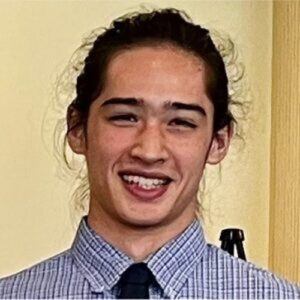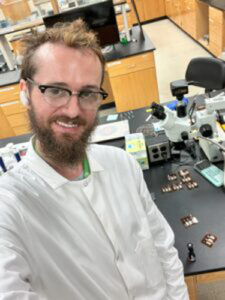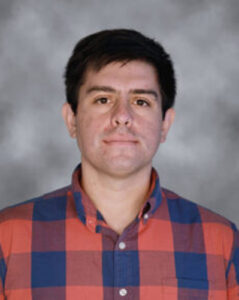2023 REU Participants

Brenna Dold
Cellular and Molecular Biology Major at Appalachian State University
Class of 2025
https://www.linkedin.com/in/brenna-dold-0b2152259/
I am currently a junior majoring in Cellular and Molecular Biology and minoring in Nutrition at Appalachian State University. I have always been passionate about biology, especially medical-based biology! It’s so incredibly interesting to be able to learn about what’s going on inside your body. Currently, I work in Dr. Anne Fanatico’s lab and Dr. Mike Hambourger’s lab working on 2 different Phosphorus projects for the STEPS center. Although I’m majoring in Biology, I am incredibly passionate about the environment, and the chemistry and development that goes into it. During my REU, I worked with Dr. Jango Bhadha at the EREC in Belle Glade, Florida. There I researched pre-flooding rice and whether anaerobic conditions impacted the uptake of Phosphorus into the soil. My future plan is to enter the Air Force under the Medical Scholarship program and obtain my MD there! Any future goals I have revolve around helping the environment and the people in it!
“It was amazing being able to work in STEPS and meet such a diverse group of people from different backgrounds and walks of life. The internship last summer was an unforgettable experience and I would do it over and over again if I could. I really appreciated being able to work with Maude and Allison and they created an absolutely amazing cohort of students!”
Research Poster: Promoting Phosphorus Sustainability Through Extension and Outreach at UF
Project Description
Giselle Magana and I studied the feasibility of pre-flooding in rice cultivation and its impact on the phosphorus availability in the Everglades agricultural area. The theory is that by inducing anaerobic conditions in pre-flooding, we will be able to utilize iron-reducing microbes to eat away at the Fe-P bond so it releases P into the soil for plant uptake. We conducted 3 treatments with 4 trays of soil in each treatment for 30 days. For Treatment 1 we did no pre-flooding, in Treatment 2 we pre-flooded after 15 days, and for Treatment 3 we preflooded the entire 30 days. While we were not able to obtain data during our time there, we predict that longer pre-flooding will equal or increase P in the soil. We took samples of our soil before, during, and after pre-flooding to measure. We also took samples of the canal water used to pre-flood the soil. For the canal water, we will measure total P, for soil measurement we will measure total p, mehlich-3 p, hot water extra table p, total fe, hot water extra table fe, and microbial activity (acid phosphatase enzyme). We predict that these measurements will result in a linear curve of increasing P availability in the soil as pre-flooding increases. We also took chlorophyll measurements of a control rice in a flooded field, which will be compared to the leaves of the experimental rice once grown. Once all the rice is cultivated, we will be able to run measurements and create result data.

Jake Cole
Physics and Chinese Major at Pomona College
Class of 2026
https://www.linkedin.com/in/jake-cole-929037207/
I am a physics and Chinese double major who somehow ended up in an organic chemistry lab. I learned more about OChem in a few months than I have about particle physics in two years. I chose to study applied physics because I hate math and love pressing buttons. I had done some research in high school, including a stint in Italy and a year-long capstone project. But none of this had prepared me to work in a lab setting so the experience I gained working with STEPS was undoubtedly invaluable. The program gave me a better understanding of how graduate school works and warmed me up considerably to pursuing higher education.
Research Poster: Amine-Based Polymer Synthesis for Phosphorus Capture
Project Description
For convenience’s sake, I’ll give a short introduction and launch into the more technical side in the next paragraph. My project under STEPS was the creation of polymers. I made small chains of molecules that can potentially trap phosphorus and later release it. The impetus behind this lies in the fact that much of our renewable phosphorus gets tied up in the water cycle, and ideally, these polymers can extract that phosphorus and allow us to reuse it. I worked on two basic monomers and a couple more polymers and was able to test them on the day before leaving.
For those who like chemistry, please buckle up. Our first monomer was mono-BOC-EDA-Acrylamide, also known as J(ake)C(ole)M(monomer). This monomer was synthesized by attaching the BOC-protecting group to one side of EDA and further thrown in with acrylamide and pyridine to complete the monomer. Afterward, it underwent emulsion polymerization (because of an emulsion’s increased surface area), and we emerged with both a homo-polymer and a crosslinked version with BIS-acrylamide. The BOC protection group was slashed off after the polymerization. The second monomer came, however, with extraordinary complications. We attempted to attach tert-Butyl alcohol to Fmoc-Beta-Alanine but found the BOC group’s bulkiness to be an issue and our yields were pitiful. We solved this by using a different chloride and initiating a Fischer esterification. After attaching the acrylamide, we found that the deprotection process sucked out a bunch of salts and that the ester wasn’t really soluble in anything other than DMS, so it was abandoned for the time being. We then conducted Molybdate Blue tests using UV-Vis Spectrometry on our linked and crosslinked polymers. While I was not present to see the analysis of the results, there was sorption present. Further characterization will be done with different amine-based side chains and potentially employing DLS.

Alex Shaw
Biology Major at Phoenix College
Class of 2025
https://www.linkedin.com/in/alexbryceshaw/
My profound connection with nature has shaped my academic journey, ushering me to pursue my destiny as an environmental scientist. Early experiences with the natural world ignited my passion for environmental studies. My journey thus far has solidified my commitment to making a meaningful impact in a respective field, harnessing my unique perspective and deep-rooted connection with the environment.
There have been many significant moments during my pursuit of higher education, but none more impactful than when I realized that no one was coming to save us. At this moment, I realized that we are all we have and must work together to formulate lasting solutions for Earth and its inhabitants. It is up to us as scientists, teachers, community members, and students to make the difference we desperately need. We have to be the reform we need. We have to be the love we need. We have to produce the answers we need.
I have never felt so close to tasting that, than this summer when I was selected for a REU internship with the STEPS center. This program is available for undergraduates who want to learn about research science and be a part of the solution. I put my entire life on hold and flew to South Carolina, where I underwent rigorous training as a STEPS scholar. We learned everything you need to know about nutrient pollution (specifically phosphorus pollution) and worked closely with leading scientists in their fight against nutrient pollution. I was placed at Clemson University at the Poole Agriculture lab and worked under Dr. Eric McLamore.
“My internship experience delving into the complex issue of phosphorus pollution has been nothing short of transformative. As I navigated the intricacies of this internship experience, it reinforced a profound sense of purpose and a burning passion for environmental science. The hands-on learning, the real-world impact, and the incredible mentors I encountered throughout this journey have left an indelible mark on me. It is this experience that has propelled me toward my destiny as an environmental scientist. This internship was not just a chapter in my academic journey; it was the spark that ignited the flames of my unwavering commitment to making a meaningful impact on our environment, one phosphorus molecule at a time.”
Research Poster: Exploring Hybrid LIG-Nanoparticle Combinations as a Phosphorous Sensing Material
Project Description
Phosphorus (P) is an essential element for all life forms and a finite resource. However, risks of ecological destabilization occur from mining phosphate rock in excess amounts considering P naturally occurs in limited quantities. P-based chemicals, such as fertilizers, pesticides, and detergents, introduce various P forms into the environment. Much of the excess P in environmental systems is in a form that is not bioavailable for plant uptake, leading to nutrient pollution, such as the eutrophication of water bodies. Nutrient pollution is a rampant issue that affects countless environmental systems. Current analytical tools for phosphorous monitoring are highly variable and costly, affecting the viability of real-time sensing. Knowledge integration should be a leading concern when implementing change in local communities most susceptible to nutrient pollution. Developing a cost-effective, real-time sensing system widely available for monitoring P levels in soil and water is critical for environmental stability.
My REU STEPS project was “Exploring hybrid LIG nanoparticle combinations as a phosphorus sensing material.” This project essentially was fabricating LIG chips using polyimides and laser-induced cutting techniques. I worked at the Poole Agro lab under Dr. Geisianny Moreira and Dr. Eric McLamore. We started by fabricating the electrode chips by hand using polyimides and laser-induced cutting techniques. Then, to match the sets, we used a Palmsense detector to run cyclic voltammetry testing. Then, we added the nanoparticles (in combinations the lab had not previously done). More rigorous testing followed, finally ending with the Phosphorus concentration testing. The experiments were labor-intensive and required tedious techniques that had to be followed precisely. Any unwanted variability would skew the testing, and we would have to start over. I was held accountable for my progress and our data analysis. This required us to learn various programs to crunch and graph numbers, leading to a successful presentation. At the end of the summer, our lab determined that adding Graphene Oxide particles with Lanthanum doped carbon dots was a possible solution for detecting phosphorus. These exciting results keep us hopeful while the techniques move forward with additional testing. Although I was prepared for any outcome, seeing this was beyond what I could have anticipated.

Kimberly Nelson
Psychology Major at the University of North Carolina at Charlotte
Class of 2025
http://www.linkedin.com/in/kimberly-nelson-238840201
At the University of North Carolina at Charlotte, I study psychology with a minor in sociology. I am fascinated about psychology because it allows me to understand why individuals think, feel, and behave the way they do. As someone who was misunderstood as a child during her critical developmental stages, I’d like to help others overcome challenges, whether it’s in areas like mental health, stress management, or personal development, and being a source of support and guidance for others is an incredibly fulfilling feeling for me.
This summer at Clemson, I had the opportunity to delve into my field of psychology by learning about the psychological dimensions of underserved communities in El Tiple, Colombia, and how their land is being changed by a pesticide. Land is being bought from families and used by large corporations to build sugarcrops, and families are being bribed to work for large corporations that want to buy the land where people in the community raise their families.
“I am glad to have applied to this Research experience with STEPS. I met wonderful people and I learned a lot. I’d recommend this experience to any undergraduate student looking to enhance their knowledge in a fun learning environment with people who support you.”
Research Poster: Sustainability and food sovereignty perspectives from the community of El Tiple in Colombia, South America
Project Description
I researched the impacts of glyphosate on the community of El Tiple, Colombia, and performed a qualitative analysis of interviews with the community leaders, shedding light on the intricate interplay between environmental changes and the psychological perceptions of the local inhabitants. Glyphosate, a widely used herbicide, has been associated with various environmental and health concerns, and my project offered a valuable perspective on its effects in a specific geographic and cultural context.
The qualitative analysis of interviews with community leaders allowed me to delve into the subjective experiences and emotions of individuals who are intimately connected to the land. By exploring their psychological perceptions, I gained insights into how environmental changes, potentially linked to glyphosate use, have impacted their sense of place, identity, and well-being. This approach goes beyond quantifiable data and offers a nuanced understanding of the human dimension of environmental issues.
My research not only highlights the importance of addressing the environmental impact of glyphosate but also underscores the need to consider the social and psychological dimensions of such changes. The experiences and perspectives of the El Tiple community leaders may serve as a case study for broader discussions on the environmental, cultural, and psychological consequences of herbicide use in agricultural and rural settings. By drawing attention to these issues, my work contributes to a more comprehensive understanding of the complex relationship between environmental changes and human psychology.

Adrian Zenteno
Chemical Engineering Major at California State University at Long Beach
Class of 2025
http://www.linkedin.com/in/adrian-zenteno-919519167
I am attending CSULB to complete a bachelor’s in Chemical Engineering. I decided to pursue chemical engineering because I wanted to focus on developing practical and advanced technical skills that will be relevant in any area of engineering and science. I want to be able to apply my skills and knowledge as an engineer to solve complex issues that include the environment, wastewater, and sustainability.
While at STEPS, I researched the comparative adsorption and desorption of phosphite and phosphate in synthetic soil minerals. I was fortunate to work at labs in the Plant Science Agronomy buildings while under the guidance of the awesome Owen Duckworth and Sarah Doydora. Sarah and Owen were extremely kind and generous and taught me so much during my internship. Sarah showed me various laboratory techniques and calculations I hadn’t seen before and she explained everything extremely well. My experience was fantastic and I learned more than I would have ever expected.
My current plans are to work on finishing my bachelor’s degree and intern at a wastewater treatment plant so I can apply many of the things I am learning at school. I hope to continue sustainability research by applying for a graduate program once I complete my bachelor’s degree. I enjoyed my research experience at STEPS and I met so many people who are passionate about what they do. I hope to see myself doing research similar to what I saw people doing at NCSU.
“STEPS had the nicest people I had ever met. My mentors were amazing and I am so lucky to have worked with the faculty at STEPS over the summer.”
Research Poster: Retention and Release of Phosphite and Phosphate in Synthetic Soil Minerals
Project Description
Phosphorus (P) fertilizers added in the form of phosphate (+5 oxidation state) are often inefficient due to the strong phosphate retention in soil. Phosphite, a reduced form of phosphorus (+3 oxidation state), may be used as an alternative P fertilizer. However, currently, there is limited work evaluating phosphite retention and release relative to phosphate in the presence of different soil minerals.
My objective for this summer internship was to evaluate how much phosphite is adsorbed and desorbed by soil minerals relative to phosphate. I researched the comparative adsorption and desorption of phosphite and phosphate in synthetic soil minerals. I presented our research findings at the summer student intern symposium at NCSU.
